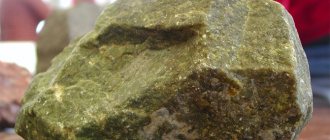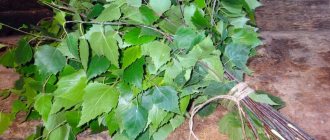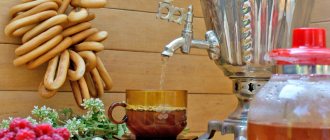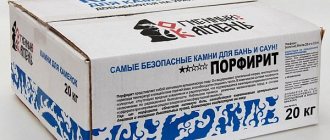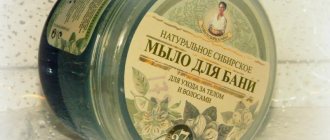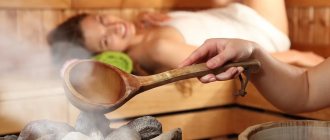To enhance the healing effect of visiting the steam room, many use medicinal herbs for the bath: by collecting and drying the plants with our own hands, we obtain a material that is unique in its properties.
Even if you focus on those species that grow only in our area, you can put together a good green first aid kit. Well, there are many ways to use these herbs, and we will talk about the most popular ones in the article below.
>
You can actively use natural medicines in the steam room
Wormwood broom for a bath: properties and features
When steamed in a bathhouse, it creates a peculiar bitter steppe aroma that disinfects the air, especially strong from the wormwood broom. Those who do not tolerate such a strong smell very well should try adding a few sprigs of wormwood to a birch or classic oak broom to soften the effect.
Why is wormwood interesting and useful in general, how was wormwood used and is used in medicine, including folk medicine, and how is a wormwood broom useful in a bathhouse?
- Wormwood contains essential oils, which are used, among other things, to aromatize the surrounding space. These oils help relieve tension, relieve fatigue and even reduce headaches;
- Other positive effects include a positive impact on overall performance and enhanced human memory;
- In addition, there is a positive effect of wormwood on sleep;
- The pronounced disinfecting properties of this plant are also known.
Pharmacological properties and use in folk medicine
Wormwood contains up to 0.6% essential oil, carotene, as well as vitamin C and rutin . It makes no sense to list the entire composition, since it is quite extensive. It is not for nothing that in folk medicine Chernobyl, also known as wormwood, has been used since ancient times.
In the 17th century in Rus', wormwood juice was used as a remedy for healing and cleaning purulent wounds.
- Decoctions are used for female diseases, dysmenorrhea and amenorrhea;
- The roots of the plant are used for neurasthenia, epilepsy and other diseases of the nervous system, as an anticonvulsant and sedative;
- In combination with other natural components, such as thyme, it is used to treat alcoholism;
- Used for tuberculous meningitis, diabetes, jaundice and problems of the gastrointestinal tract;
- In the East, wormwood was used in the treatment of cholera and leprosy, and also as a hemostatic agent;
- For bruises, wormwood is used as a compress;
- Wormwood paniculata is used to treat diseases of the lower respiratory tract, is used for rheumatism, and also as a diuretic.
And finally, don’t forget about the positive impact of the process of steaming with any broom. And this, combined with the above-mentioned positive properties of the plant, makes a trip to the steam room with a wormwood broom a real journey for a portion of health and pleasure.
Using Herbs
Zaparki
A herbal bath involves the use of medicinal plants in a variety of forms. And the most commonly used form is steaming. Steaming is a decoction or infusion of herbs designed to produce water vapor with suspended substances. We pour the steaming mixture prepared in advance in small portions onto the heater of the bathhouse, where it evaporates almost instantly.
Preparing herbal decoction
The cooking instructions are as follows:
- Grind all the ingredients of the steaming into fragments no larger than 10 mm in size.
Advice! For cooking, we use exclusively whole leaves and stems, without signs of rotting, damage by insects, etc.
- We mix the herbs in the required proportions (we will give several recipes below), after which we place the resulting mixture in an enamel container.
- Fill the plants with boiling water (1.5 - 2 l), put on fire and bring to a boil. After boiling, close the lid and simmer over low heat for about an hour.
- The resulting broth is filtered and, after cooling, stored in a cool, dark place. Experts recommend preparing steaming for no more than one and a half to two months.
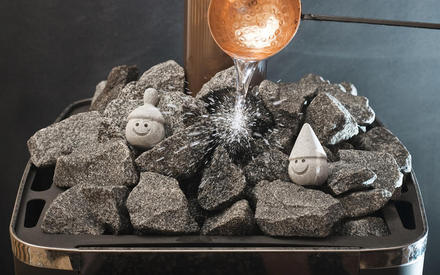
Pour the parka onto the stones
For use in a steam room, you can use several compositions:
- Bactericidal, including equal volumes of mint, thyme, eucalyptus and sage. You should use this decoction the first time you enter the steam room, since the resulting steam does an excellent job of disinfecting steamed skin. Yes, and essential oils in the air have an extremely positive effect.
- Relaxing – mint, chamomile, thyme, spruce needles, chamomile (1 part each). The use of such a steamer will be especially useful for heavy smokers, as well as for those who are trying to break this bad habit. The calming effect of steam makes withdrawal symptoms much easier to bear.
- Toning - helps to gain strength. For the decoction, tansy flowers, bison, poplar buds, etc. are used. The use of this decoction is recommended primarily for those who experience weakness when visiting a steam room. Also, to enhance the tonic effect, you should add lavender or jasmine to the composition.
Herbal teas
In addition to steaming, you can also use herbal teas for baths. In fact, they do not contain the tea leaf at all, so they are decoctions of medicinal herbs.
The most common recipes include:
- Lingonberry tea - infusion of 1 spoon of dry lingonberry leaf in a glass of boiling water. It has a diuretic effect, and together with honey it helps against colds.
- Cranberry tea - mash berries (fresh or frozen) with sugar and pour boiling water. The resulting infusion has an antipyretic effect and also stimulates appetite.
- St. John's wort decoction - pour a teaspoon of boiling water and leave for about half an hour. The taste is not for everyone, but this tea normalizes intestinal function and has an antiseptic effect.
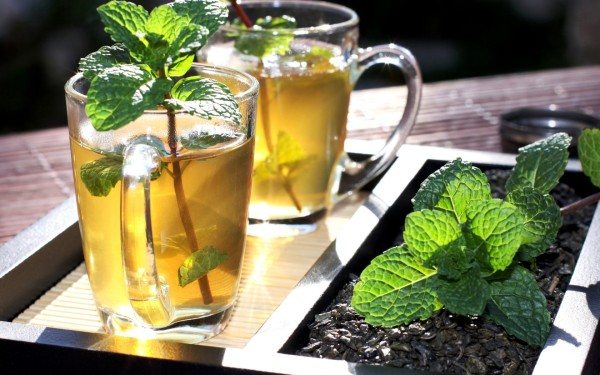
Mint tea
Black currant leaves, mint, rose hips, thyme, etc. are also used for drinking decoctions.
How to prepare and store wormwood bath brooms?
When preparing wormwood brooms, you should know that different types of wormwood have different properties, and some types of wormwood need to be handled with care. Some of them are poisonous. For example, wormwood , poisonous to many animals, at certain stages of its development, is undesirable to use in the manufacture of brooms.
Although it is also a well-known medicinal plant and has long been successfully used in folk medicine. But if you are not an expert in traditional medicine, turn your attention to more conservative and proven types of wormwood.
To make brooms, it is recommended to harvest the following types of wormwood: common, bitter, paniculata, lemon .
Brooms are prepared in July-August immediately after flowering, until the wormwood stems have dried. The brooms are made loose. The length of the brooms is about 50 centimeters; the leaves are removed in the area of the handle. After production, the brooms are first slightly dried in the sun and only then hung for storage in the shade. During the drying process, exposure to direct sunlight is unacceptable.
With proper storage, the leaves of wormwood brooms do not lose either their color or aroma. By carrying out the correct collection and proper storage, you can get a bath broom made of wormwood of the highest quality, which you would never buy in a store.
Since brooms collected only from wormwood are fragile, they, like brooms from nettle, are often made mixed, with the addition of stronger branches, such as birch or oak. Wormwood in a birch broom is the most common use in a steam room.
Features of preparing infusions and decoctions
In order for bath herbs to act more effectively, infusions and decoctions must be prepared correctly.
The raw materials from which herbal infusions for the bath will be prepared must be thoroughly dried in a room deprived of sunlight, well ventilated and dry.
After drying, the raw materials are crushed. The fruits and seeds need to be crushed until they resemble semolina. The size of crushed leaves and flowers should not exceed 0.5 cm, and the size of bark, stems and roots - 0.3 cm. Some recipes suggest preparing an infusion from whole parts of the plant.
Raw materials, placed in a tightly sealed container, should be stored in dark and cool conditions. It is better to place different plants in separate jars. Before preparing the infusion, the components can be mixed in the required proportions. It is advisable that the dishes have a mark on the time of collection of raw materials, since leaves, flowers and herbs are stored for no more than 2 years. Berries and fruits retain their beneficial properties for about 4 years.
Before infusion, it is better to place the crushed herbs for the bath in a gauze bag. Then it is immersed in a container of hot water for 30 minutes. Some compositions can be infused for several hours.
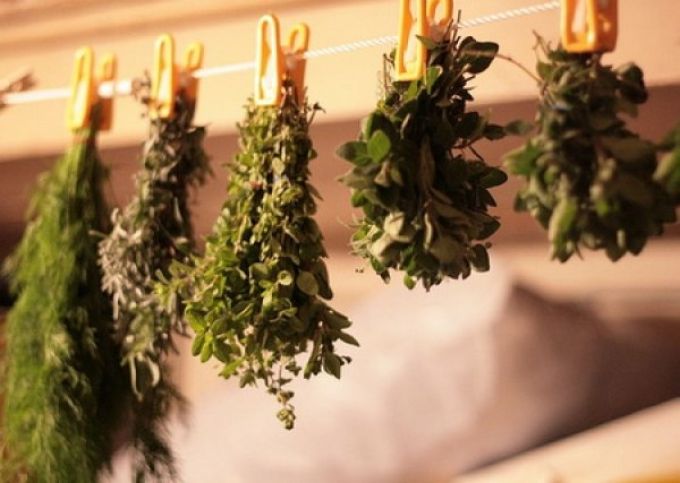
The decoction is prepared as follows:
- About 100 g of a mixture of medicinal herbs should be placed in an enamel or stainless steel container.
- Pour 4 liters of boiling water into a saucepan.
- The dish, covered with a lid, should be placed on low heat. The mixture should cook for 5-10 minutes.
- After cooling in a closed pan, the broth is filtered through doubled gauze.
Now you can splash it on the heater. The shelf life of the decoction is no more than 2 days. Dishes with it should be kept in a cool room.
Distinctive features of some types of wormwood
In total, there are more than 400 species of wormwood in the world, of which about 180 grow in Russia. Most often it is found in the steppes, less often in semi-deserts. The most common type is wormwood or Chernobyl. It grows everywhere, you can see it on the streets, along roads, in vegetable gardens, near fences, in vacant lots.
The plant can reach a height of up to one and a half meters, sometimes reddish in color. The leaves have a pinnately dissected blade. Small reddish oval baskets on the tops of the stems are collected in characteristic inflorescences - panicles. Flowering continues from spring to autumn, usually May to September. Chernobyl differs from many of its other relatives, for example, from wormwood. The difference is that the specific pubescence on the leaves is present exclusively on the underside, while the leaves are dark green on top.
Wormwood paniculata is distinguished by pinnately dissected leaves into narrow filiform or linear-lanceolate lobules.
Fragrant bath
In a Russian bath, in addition to the pleasure of washing, whipping with a broom, heat that warms you to the bones, splashing in the water and other joys, a significant share of the pleasure comes from pleasant smells. It has long been customary to “serve” hot stones not only with water, but also with kvass, beer, and even better, with herbal infusions or decoctions. However, we do not always have time to prepare them, and then ready-made tinctures help us out. Scented and medicinal herbs and leaves are very good for a bath - oregano, wormwood, eucalyptus and others (read more about the use of eucalyptus tincture here).
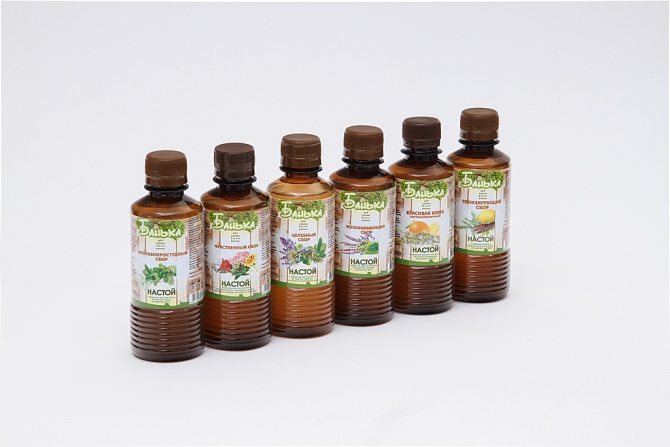
Bath tinctures: types
By choosing the right combinations, you can not only enjoy the pleasant smells, but also improve your well-being, prevent the onset of the disease, or even cure it in the initial stages. It should, however, be noted that by using the “wrong” aroma, we risk achieving exactly the opposite results, so we need to be careful when choosing herbs.
Ready-made decoctions (now even decoctions!) and tinctures for the bath can be bought, but people who love the leisurely ritual of preparing for the steam room can easily make them with their own hands. To “give in” they are usually diluted with water.
Steaming a wormwood broom and steaming
Before steaming, immerse the wormwood broom in cold water for about twenty minutes, then keep it in warm water for 5-7 minutes. If the broom is made from freshly plucked branches, there is no need to steam it. To create a stronger aroma in the bathhouse, you can pour boiling water over a wormwood broom.
You need to steam with such a broom carefully, as it is very weak, except when birch or oak branches are added to the broom. Body massage with a wormwood broom is very useful.
In any case, if you are a true connoisseur of the Russian bathhouse, and going to the steam room with a birch broom has become a habit for you, do not pass by the wormwood! The benefits of a wormwood broom are undeniable, and the pleasure of soaring will be unforgettable.
Tags
broom bath broom wormwood broom health wormwood broom benefits
Bath with garlic and onions
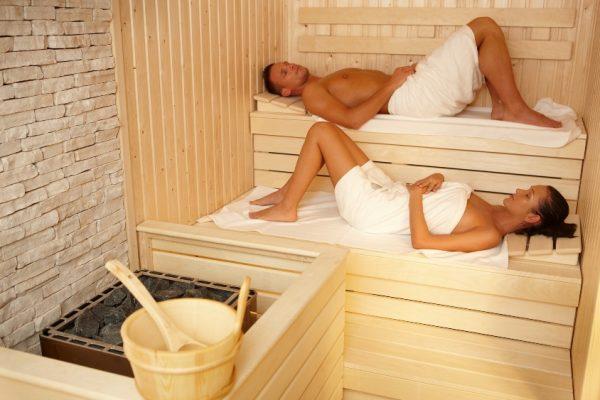
Garlic steam has an unrecognizable aroma in the bath
Onions, like garlic, are rich in phytoncides, so they help fight bacterial infections. A decoction for a bath is not made from onions. It is finely chopped and placed on the bath shelf in a plate. You can eat a few pieces of onion in a heated bath. When combined with garlic steam, it has a significant healing effect.
Video: garlic bath
Any aromatherapy in a bath should be approached responsibly. Onion and garlic steam will be beneficial if you inhale it for about 10 minutes. For a person with an allergy to essential oils of plants, such procedures are generally contraindicated.
I love going to the bathhouse. There is no substitute for a bath like a parka in a steam room. So sometimes I go and get this pleasure for myself.
Nowadays, many people in baths, not just me, want to have full pleasure, so they come up with a lot of things in steam rooms. Not so long ago I went to the bathhouse and noticed that just like that, without anything, now almost no steam is made. Somehow it's not interesting. Usually served with mint tincture or some kind of pine tincture. But sometimes something happens that is not quite familiar, or even completely unusual. So this time we made steam with mint tincture only once. Well, then... and then it started. The women first came up with the idea of steaming with beer, then with mustard (to hell with them, it’s such a pleasure!), and then...
After the mustard parka, some women wanted a more thorough steaming - steam with garlic. For some reason they themselves did not know how to prepare such steam and decided to invite... a man for this task. At first I thought it was some kind of joke, but then I realized that they were not joking. Voices about inviting a man to give him garlic were heard more and more insistently, and finally a joint decision was made: to invite him and collect money for his work. Well, the money is small, about 200 rubles somewhere, or maybe a little more. In short, they decided to collect 20 rubles from everyone and call the guy. I also threw in my pennies, I couldn’t tear myself away from the team, and I wanted to see what it would be like.
Collection of herbs for the bath – Sweet clover
The healing power of sweet clover was noted by our distant ancestors. The ancient herbal book even devotes several pages to it, on which one of the first recommendations for the use of sweet clover is its use in bath procedures. Using the advice of your great-grandfathers, you can improve your own body and relieve nervous tension, even eliminating attacks of hysteria or melancholy.
The collection of herbs for the sauna, sweet clover, due to its healing power, helps relieve cardiospasms and strengthen the cardiovascular system. In addition, by inhaling the “delicious aroma” of this plant, the steamer gets rid of respiratory diseases, because this herb has excellent expectorant and mucus-thinning properties. The herb for the bathhouse, sweet clover, will perfectly help in the treatment of all kinds of skin diseases, as well as in the healing of cuts and wounds.
However, not only treatment and relaxation becomes available to you when you take a steam bath using the collection of this plant. If you believe magicians and sorcerers, it turns out that the aroma of sweet clover protects against the evil eye, eliminates damage caused to a person and at the same time neutralizes negative energy. Whether this is true or not is difficult to judge. But the fact that after a bathhouse with sweet clover you feel as if you were born again is true!
Using steam in bags in baths and saunas
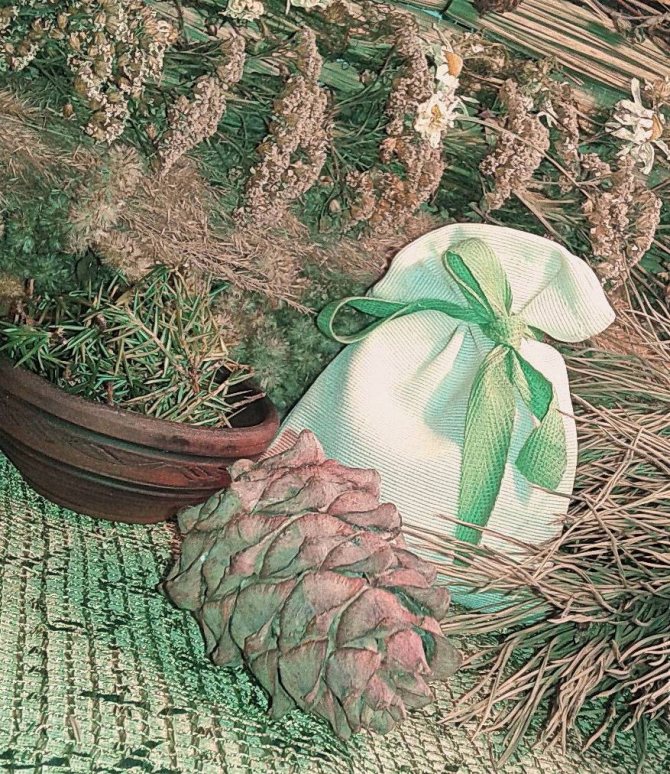
In the Russian steam room, bags of herbs are used to prepare an infusion, which is then poured onto the heater and shelves. The steaming mixture is placed in hot, but not brought to a boil, water for 20-30 minutes. The resulting infusion is poured using a ladle onto not very hot stones - they are first doused with ordinary water a couple of times. The infusion should be added carefully, making sure that the concentration of essential oils in the steam room is reasonable. Essential oils are substances that have a noticeable effect on the human condition, therefore, in addition to choosing the most suitable oil for a particular situation, care must be taken to ensure that there is no overdose.
In addition to evaporation, the herbal infusion can also be sprayed onto the shelves and walls of the steam room using a broom. This method is especially effective if the steam room is not equipped with a heater and the steam is supplied using a steam generator. In the sauna, steaming agents are used in the same way - the resulting infusion is sprinkled in the room.
A fair question arises: why can’t you use dried herbs in their original form, without bags? Everything is quite obvious - if you simply steam dried plants in hot water and then pour this water onto the heater, then parts of the herbs will fall on the heater and fill the air with a burning smell. The second reason for using steaming is the ability to apply a soaked bag to different parts of the body for cosmetic or medicinal purposes.
What to remember
Following simple rules will help you avoid unpleasant moments:
- Before you “succumb” to this or that decoction, find out if any of those steaming are allergic to the plant; and since we ourselves do not always know what we are allergic to, the concentration of the decoction (tincture) should be small at first.
- If aromatic oils are added to the heater water, make sure that they are essential oils and not fatty ones. Base oil, even if it is flavored, burns when it comes into contact with hot stones, releasing an unpleasant odor and fumes.
- Tonic and stimulating herbs and herbs should be used only in the first half of the day. At night, it is better to take something soothing to promote relaxation.
- Take special care with medicinal plants. Remember the contraindications! Example: for those with low blood pressure, it is better not to use mint, rowan, hawthorn (read about its use here), mistletoe, and barberry. If you are prone to high blood pressure, avoid tansy, immortelle, and St. John's wort.
- When using decoctions and tinctures for a bath, choose herbs with the same effect; For example, you should not mix stimulants and sedatives.
And another tip - fragrant decoctions and bath tinctures are very pleasant to use for dousing after a steam room.
Rate this post
